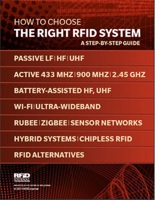Jan 01, 2011
Published: April 2011, Updated June 2015
Number of pages: 37
Price: $299
Get this report for $199 with a new membership to RFID Journal:
Add subscription and report to cart.
Choosing the proper radio frequency identification system for your application can be a daunting task, and some systems integrators try to sell customers the solution with which they are most familiar—even if it isn't the most suitable for the job. Now, for the first time, RFID Journal provides a guide to choosing the right system for your needs, and explains the pros and cons of different RFID solutions for different applications.
 This report details the many types of RFID technologies, including passive low-frequency (LF), high-frequency (HF) and ultrahigh-frequency (UHF) 433 MHz, 900 MHz and 2.4 GHz active systems; ultra-wideband (UWB); ZigBee; Wi-fi; and more. Plus, it features descriptions covering a wide variety of hybrid tags, including tags that combine RFID with infrared, GPS and sensors. This ultimate guide will help ensure that you choose the most suitable system to do the job at the lowest cost—get this newly released report now, at this special rate.
This report details the many types of RFID technologies, including passive low-frequency (LF), high-frequency (HF) and ultrahigh-frequency (UHF) 433 MHz, 900 MHz and 2.4 GHz active systems; ultra-wideband (UWB); ZigBee; Wi-fi; and more. Plus, it features descriptions covering a wide variety of hybrid tags, including tags that combine RFID with infrared, GPS and sensors. This ultimate guide will help ensure that you choose the most suitable system to do the job at the lowest cost—get this newly released report now, at this special rate.
RFID Journal's editors created this special report to help businesses choose the RFID technology that can best meet their needs in both the short and long term. It is designed to walk companies through the process of determining their needs, and then matching those requirements to the proper RFID system. This document provides detailed information regarding the performance characteristics, standards, strengths, weaknesses and common applications for each type of passive, active and battery-assisted RFID system.
No report can conclusively determine the right RFID system for a company's particular needs, but this guide will help those charged with selecting a system narrow the options. Our goal is to reduce the time businesses spend researching the appropriate system, and to provide the information they need to choose a systems integrator and, perhaps, hardware and software providers (a good systems integrator will help with the technology-selection process).
|
Table of Contents
Part 1
What Is RFID?
The Major Types of RFID Systems
Passive
Active
Battery-Assisted
Part 2
A Step-by-Step Guide to Choosing the Right RFID System for Your Application
1. Determine whether you want to deploy RFID as a point solution to solve one
problem, or as an infrastructure approach to solve multiple problems.
2. Determine which objects and/or people you would like to track.
3. Determine over what distance each object or person needs to be identified
and tracked.
4. Determine the location accuracy required for each item being tracked, as well
as the layout of the environment.
5. Create a table within which you can place each item on your list.
6. Consider other factors that might influence which system is most appropriate:
• How large is the asset?
• How critical is knowledge of the asset's location?
• What other RF devices are in operation in the area in which the RFID
system will be used?
• Do you need to monitor the item's condition?
• How much will deploying the system disrupt existing operational activities?
• Does the system need to be intrinsically safe or HERO-compliant?
• How important is data security?
• What is the total cost of ownership?
7. Prioritize the benefits of tracking and managing the objects, or groups of objects,
on your list.
8. Engage the services of a good system integrator.
9. Pilot the system.
10. Roll out the system and expand it as needed.
Part 3
The Different Types of Passive RFID Systems
Passive
Low-Frequency
High-Frequency
Ultrahigh-Frequency
Passive Real-Time Locating Systems
Ultrahigh-Frequency
Ultra-wideband
Part 4
The Different Types of Active RFID Systems
Active
ISO-18000-7
RuBee
Proprietary Systems
Active Real-Time Locating Systems
ZigBee
Wi-Fi
Ultra-wideband
Proprietary Systems
Part 5
Battery-Assisted RFID Systems
Part 6
Hybrid RFID Systems
RFID and Infrared
RFID and GPS
RFID and GPRS
Part 7
RFID Sensor Networks
Part 8
Chipless RFID Systems
RF-Resonant Fibers
RF-Resonant Inks
Part 9
Alternatives to RFID
Infrared
Ultrasound
Appendices
1. The Components of an RFID System
2. RFID Applications
3. Leading RFID Technology Providers
Get this informative new guide now for just $299.
.
